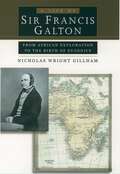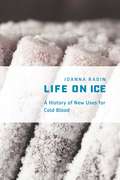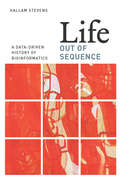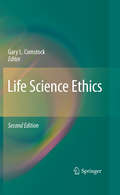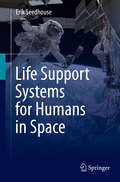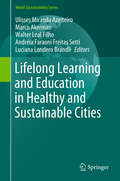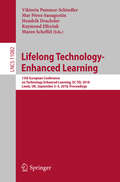- Table View
- List View
A Life of Sir Francis Galton: From African Exploration to the Birth of Eugenics
by Nicholas Wright GillhamFew scientists have made lasting contributions to as many fields as Francis Galton. He was an important African explorer, travel writer, and geographer. He was the meteorologist who discovered the anticyclone, a pioneer in using fingerprints to identify individuals, the inventor of regression and correlation analysis in statistics, and the founder of the eugenics movement. Now, Nicholas Gillham paints an engaging portrait of this Victorian polymath. The book traces Galton's ancestry (he was the grandson of Erasmus Darwin and the cousin of Charles Darwin), upbringing, training as a medical apprentice, and experience as a Cambridge undergraduate. It recounts in colorful detail Galton's adventures as leader of his own expedition in Namibia. Darwin was always a strong influence on his cousin and a turning point in Galton's life was the publication of the Origin of Species. Thereafter, Galton devoted most of his life to human heredity, using then novel methods such as pedigree analysis and twin studies to argue that talent and character were inherited and that humans could be selectively bred to enhance these qualities. To this end, he founded the eugenics movement which rapidly gained momentum early in the last century. After Galton's death, however, eugenics took a more sinister path, as in the United States, where by 1913 sixteen states had involuntary sterilization laws, and in Germany, where the goal of racial purity was pushed to its horrific limit in the "final solution." Galton himself, Gillham writes, would have been appalled by the extremes to which eugenics was carried. Here then is a vibrant biography of a remarkable scientist as well as a superb portrait of science in the Victorian era.
Life on Ice: A History of New Uses for Cold Blood
by Joanna RadinAfter the atomic bombing at the end of World War II, anxieties about survival in the nuclear age led scientists to begin stockpiling and freezing hundreds of thousands of blood samples from indigenous communities around the world. These samples were believed to embody potentially invaluable biological information about genetic ancestry, evolution, microbes, and much more. Today, they persist in freezers as part of a global tissue-based infrastructure. In Life on Ice, Joanna Radin examines how and why these frozen blood samples shaped the practice known as biobanking. The Cold War projects Radin tracks were meant to form an enduring total archive of indigenous blood before it was altered by the polluting forces of modernity. Freezing allowed that blood to act as a time-traveling resource. Radin explores the unique cultural and technical circumstances that created and gave momentum to the phenomenon of life on ice and shows how these preserved blood samples served as the building blocks for biomedicine at the dawn of the genomic age. In an era of vigorous ethical, legal, and cultural debates about genetic privacy and identity, Life on Ice reveals the larger picture—how we got here and the promises and problems involved with finding new uses for cold human blood samples.
Life on Ice: A History of New Uses for Cold Blood
by Joanna RadinAfter the atomic bombing at the end of World War II, anxieties about survival in the nuclear age led scientists to begin stockpiling and freezing hundreds of thousands of blood samples from indigenous communities around the world. These samples were believed to embody potentially invaluable biological information about genetic ancestry, evolution, microbes, and much more. Today, they persist in freezers as part of a global tissue-based infrastructure. In Life on Ice, Joanna Radin examines how and why these frozen blood samples shaped the practice known as biobanking. The Cold War projects Radin tracks were meant to form an enduring total archive of indigenous blood before it was altered by the polluting forces of modernity. Freezing allowed that blood to act as a time-traveling resource. Radin explores the unique cultural and technical circumstances that created and gave momentum to the phenomenon of life on ice and shows how these preserved blood samples served as the building blocks for biomedicine at the dawn of the genomic age. In an era of vigorous ethical, legal, and cultural debates about genetic privacy and identity, Life on Ice reveals the larger picture—how we got here and the promises and problems involved with finding new uses for cold human blood samples.
Life on Ice: A History of New Uses for Cold Blood
by Joanna RadinAfter the atomic bombing at the end of World War II, anxieties about survival in the nuclear age led scientists to begin stockpiling and freezing hundreds of thousands of blood samples from indigenous communities around the world. These samples were believed to embody potentially invaluable biological information about genetic ancestry, evolution, microbes, and much more. Today, they persist in freezers as part of a global tissue-based infrastructure. In Life on Ice, Joanna Radin examines how and why these frozen blood samples shaped the practice known as biobanking. The Cold War projects Radin tracks were meant to form an enduring total archive of indigenous blood before it was altered by the polluting forces of modernity. Freezing allowed that blood to act as a time-traveling resource. Radin explores the unique cultural and technical circumstances that created and gave momentum to the phenomenon of life on ice and shows how these preserved blood samples served as the building blocks for biomedicine at the dawn of the genomic age. In an era of vigorous ethical, legal, and cultural debates about genetic privacy and identity, Life on Ice reveals the larger picture—how we got here and the promises and problems involved with finding new uses for cold human blood samples.
Life on Ice: A History of New Uses for Cold Blood
by Joanna RadinAfter the atomic bombing at the end of World War II, anxieties about survival in the nuclear age led scientists to begin stockpiling and freezing hundreds of thousands of blood samples from indigenous communities around the world. These samples were believed to embody potentially invaluable biological information about genetic ancestry, evolution, microbes, and much more. Today, they persist in freezers as part of a global tissue-based infrastructure. In Life on Ice, Joanna Radin examines how and why these frozen blood samples shaped the practice known as biobanking. The Cold War projects Radin tracks were meant to form an enduring total archive of indigenous blood before it was altered by the polluting forces of modernity. Freezing allowed that blood to act as a time-traveling resource. Radin explores the unique cultural and technical circumstances that created and gave momentum to the phenomenon of life on ice and shows how these preserved blood samples served as the building blocks for biomedicine at the dawn of the genomic age. In an era of vigorous ethical, legal, and cultural debates about genetic privacy and identity, Life on Ice reveals the larger picture—how we got here and the promises and problems involved with finding new uses for cold human blood samples.
Life on Other Planets: A Memoir of Finding My Place in the Universe
by Aomawa ShieldsAs a child, Aomawa Shields was always bumping into things, her neck craned up at the sky, dreaming of becoming an astronaut. A year into an astrophysics PhD program, plagued by self-doubt and discouraged by a white male professor who suggested that she - a young Black woman who also loved fashion, makeup, and the arts - didn't belong, she left astronomy and pursued acting professionally for a decade, before a day job working for NASA's Spitzer Space Telescope drew her back to the stars. She was the oldest and the only Black student in her PhD cohort. This time, no professor, and no voice in her own head, would stop her.Now an astronomer and astrobiologist at the top of her field, Dr Shields studies the universe outside our solar system, researching and uncovering the planets circling distant stars with just the right conditions that could support life. But it's been a road as winding and complex as the physics she has mastered.Life on Other Planets is a journey of discovery on this world and on others, a story of creating a life that makes space for joy, love and wonder while being driven by one of our biggest questions: is anybody else out there? It is about the possibility of living between multiple worlds and not choosing - but instead charting a new path entirely.
Life-Oriented Behavioral Research for Urban Policy
by Junyi ZhangThis book presents a life-oriented approach, which is an interdisciplinary methodology proposed for cross-sectoral urban policy decisions such as transport, health, and energy policies. Improving people’s quality of life (QOL) is one of the common goals of various urban policies on the one hand, while QOL is closely linked with a variety of life choices on the other. The life-oriented approach argues that life choices in different domains (e.g., residence, neighborhood, health, education, work, family life, leisure and recreation, finance, and travel behavior) are not independent of one another, and ignorance of and inability to understand interdependent life choices may result in a failure of consensus building for policy decisions. The book provides evidence about behavioral interdependencies among life domains based on both extensive literature reviews and case studies covering a broad set of life choices. This work further illustrates interbehavioral analysis frameworks with respect to various life domains, along with a rich set of future research directions. This book deals with life choices in a relatively general way. Thus, it can serve not only as a reference for research, but also as a textbook for teaching and learning in varied behavior-related disciplines.
Life Out of Sequence: A Data-Driven History of Bioinformatics
by Hallam StevensThirty years ago, the most likely place to find a biologist was standing at a laboratory bench, peering down a microscope, surrounded by flasks of chemicals and petri dishes full of bacteria. Today, you are just as likely to find him or her in a room that looks more like an office, poring over lines of code on computer screens. The use of computers in biology has radically transformed who biologists are, what they do, and how they understand life. In Life Out of Sequence, Hallam Stevens looks inside this new landscape of digital scientific work. Stevens chronicles the emergence of bioinformatics—the mode of working across and between biology, computing, mathematics, and statistics—from the 1960s to the present, seeking to understand how knowledge about life is made in and through virtual spaces. He shows how scientific data moves from living organisms into DNA sequencing machines, through software, and into databases, images, and scientific publications. What he reveals is a biology very different from the one of predigital days: a biology that includes not only biologists but also highly interdisciplinary teams of managers and workers; a biology that is more centered on DNA sequencing, but one that understands sequence in terms of dynamic cascades and highly interconnected networks. Life Out of Sequence thus offers the computational biology community welcome context for their own work while also giving the public a frontline perspective of what is going on in this rapidly changing field.
Life Out of Sequence: A Data-Driven History of Bioinformatics
by Hallam StevensThirty years ago, the most likely place to find a biologist was standing at a laboratory bench, peering down a microscope, surrounded by flasks of chemicals and petri dishes full of bacteria. Today, you are just as likely to find him or her in a room that looks more like an office, poring over lines of code on computer screens. The use of computers in biology has radically transformed who biologists are, what they do, and how they understand life. In Life Out of Sequence, Hallam Stevens looks inside this new landscape of digital scientific work. Stevens chronicles the emergence of bioinformatics—the mode of working across and between biology, computing, mathematics, and statistics—from the 1960s to the present, seeking to understand how knowledge about life is made in and through virtual spaces. He shows how scientific data moves from living organisms into DNA sequencing machines, through software, and into databases, images, and scientific publications. What he reveals is a biology very different from the one of predigital days: a biology that includes not only biologists but also highly interdisciplinary teams of managers and workers; a biology that is more centered on DNA sequencing, but one that understands sequence in terms of dynamic cascades and highly interconnected networks. Life Out of Sequence thus offers the computational biology community welcome context for their own work while also giving the public a frontline perspective of what is going on in this rapidly changing field.
Life Out of Sequence: A Data-Driven History of Bioinformatics
by Hallam StevensThirty years ago, the most likely place to find a biologist was standing at a laboratory bench, peering down a microscope, surrounded by flasks of chemicals and petri dishes full of bacteria. Today, you are just as likely to find him or her in a room that looks more like an office, poring over lines of code on computer screens. The use of computers in biology has radically transformed who biologists are, what they do, and how they understand life. In Life Out of Sequence, Hallam Stevens looks inside this new landscape of digital scientific work. Stevens chronicles the emergence of bioinformatics—the mode of working across and between biology, computing, mathematics, and statistics—from the 1960s to the present, seeking to understand how knowledge about life is made in and through virtual spaces. He shows how scientific data moves from living organisms into DNA sequencing machines, through software, and into databases, images, and scientific publications. What he reveals is a biology very different from the one of predigital days: a biology that includes not only biologists but also highly interdisciplinary teams of managers and workers; a biology that is more centered on DNA sequencing, but one that understands sequence in terms of dynamic cascades and highly interconnected networks. Life Out of Sequence thus offers the computational biology community welcome context for their own work while also giving the public a frontline perspective of what is going on in this rapidly changing field.
Life Out of Sequence: A Data-Driven History of Bioinformatics
by Hallam StevensThirty years ago, the most likely place to find a biologist was standing at a laboratory bench, peering down a microscope, surrounded by flasks of chemicals and petri dishes full of bacteria. Today, you are just as likely to find him or her in a room that looks more like an office, poring over lines of code on computer screens. The use of computers in biology has radically transformed who biologists are, what they do, and how they understand life. In Life Out of Sequence, Hallam Stevens looks inside this new landscape of digital scientific work. Stevens chronicles the emergence of bioinformatics—the mode of working across and between biology, computing, mathematics, and statistics—from the 1960s to the present, seeking to understand how knowledge about life is made in and through virtual spaces. He shows how scientific data moves from living organisms into DNA sequencing machines, through software, and into databases, images, and scientific publications. What he reveals is a biology very different from the one of predigital days: a biology that includes not only biologists but also highly interdisciplinary teams of managers and workers; a biology that is more centered on DNA sequencing, but one that understands sequence in terms of dynamic cascades and highly interconnected networks. Life Out of Sequence thus offers the computational biology community welcome context for their own work while also giving the public a frontline perspective of what is going on in this rapidly changing field.
Life Out of Sequence: A Data-Driven History of Bioinformatics
by Hallam StevensThirty years ago, the most likely place to find a biologist was standing at a laboratory bench, peering down a microscope, surrounded by flasks of chemicals and petri dishes full of bacteria. Today, you are just as likely to find him or her in a room that looks more like an office, poring over lines of code on computer screens. The use of computers in biology has radically transformed who biologists are, what they do, and how they understand life. In Life Out of Sequence, Hallam Stevens looks inside this new landscape of digital scientific work. Stevens chronicles the emergence of bioinformatics—the mode of working across and between biology, computing, mathematics, and statistics—from the 1960s to the present, seeking to understand how knowledge about life is made in and through virtual spaces. He shows how scientific data moves from living organisms into DNA sequencing machines, through software, and into databases, images, and scientific publications. What he reveals is a biology very different from the one of predigital days: a biology that includes not only biologists but also highly interdisciplinary teams of managers and workers; a biology that is more centered on DNA sequencing, but one that understands sequence in terms of dynamic cascades and highly interconnected networks. Life Out of Sequence thus offers the computational biology community welcome context for their own work while also giving the public a frontline perspective of what is going on in this rapidly changing field.
Life Out of Sequence: A Data-Driven History of Bioinformatics
by Hallam StevensThirty years ago, the most likely place to find a biologist was standing at a laboratory bench, peering down a microscope, surrounded by flasks of chemicals and petri dishes full of bacteria. Today, you are just as likely to find him or her in a room that looks more like an office, poring over lines of code on computer screens. The use of computers in biology has radically transformed who biologists are, what they do, and how they understand life. In Life Out of Sequence, Hallam Stevens looks inside this new landscape of digital scientific work. Stevens chronicles the emergence of bioinformatics—the mode of working across and between biology, computing, mathematics, and statistics—from the 1960s to the present, seeking to understand how knowledge about life is made in and through virtual spaces. He shows how scientific data moves from living organisms into DNA sequencing machines, through software, and into databases, images, and scientific publications. What he reveals is a biology very different from the one of predigital days: a biology that includes not only biologists but also highly interdisciplinary teams of managers and workers; a biology that is more centered on DNA sequencing, but one that understands sequence in terms of dynamic cascades and highly interconnected networks. Life Out of Sequence thus offers the computational biology community welcome context for their own work while also giving the public a frontline perspective of what is going on in this rapidly changing field.
Life Science Ethics
by Gary L. ComstockDoes nature have intrinsic value? Should we be doing more to save wilderness and ocean ecosystems? What are our duties to future generations of humans? Do animals have rights? This revised edition of "Life Science Ethics" introduces these questions using narrative case studies on genetically modified foods, use of animals in research, nanotechnology, and global climate change, and then explores them in detail using essays written by nationally-recognized experts in the ethics field. Part I introduces ethics, the relationship of religion to ethics, how we assess ethical arguments, and a method ethicists use to reason about ethical theories. Part II demonstrates the relevance of ethical reasoning to the environment, land, farms, food, biotechnology, genetically modified foods, animals in agriculture and research, climate change, and nanotechnology. Part III presents case studies for the topics found in Part II.
Life: The Science of Biology (Chapters 1- 23)
by David Sadava H. Craig Heller Dave Hall David Hillis Sally D. Hacker Marta LaskowskiThe 12th edition of Life: The Science of Biology continues to be engaging, active, and focused on teaching the skills that students need to master.New pedagogical features support the mission of Life by teaching students the skills and understanding of experimentation and data they need to succeed in introductory biology and ultimately in their future STEM careers. Life’s potent combination of expertly crafted pedagogy and engagement makes this new edition the best resource yet for biology students.
The Life Scientific: Explorers
by Anna BuckleyInspiring life stories from BBC Radio 4's hit series The Life Scientific'In showing non-scientists why science offers so many paths to discovery it has no equal' Gillian Reynolds, TelegraphBased on Jim Al-Khalili's ground-breaking interviews, The Life Scientific: Explorers takes science out of its box and introduces us to the men and women who make it happen.The explorers featured in this volume include: Michele Dougherty, the mathematician who persuaded the Cassini mission to Saturn to make a diversion; Richard Fortey on his love of trilobites; Monica Grady, Meteorite Lady; neurosurgeon Henry Marsh on slicing through our thoughts; the Director of the British Antarctic Survey, Jane Francis; Jocelyn Bell Burnell describing how she missed out on a Nobel Prize; Brian Cox on quantum mechanics; and Nobel Prize winner John Sulston on why he thought it would be a good idea to sequence the human genome.
The Life Scientific: Inventors
by Anna BuckleyWhat does it take to be an inventor? Judging by the ingenious individuals who have come into The Life Scientific studio in the last eight years, there is no simple answer. Mathematicians, electricians, molecular biologists and mechanics can all transform lives. Some think with their hands, others make things in their minds. Most have a vision of the future. All are driven by a passionate determination to solve problems.These intimate accounts, based on interviews recorded for the popular BBC Radio 4 programme The Life Scientific, chart the life journeys of scientists and engineers working in Britain today from childhood interests to innovation. Explaining what they did when and why, they make science seem straightforward and exciting, revealing moments of disappointment, creativity, frustration and joy. The result is an illuminating collection of biographical short stories that make scientists and the work they do accessible to us all.
Life Support Systems for Humans in Space
by Erik SeedhouseLife support systems are an integral part of crewed spacecraft designs and habitation systems. This textbook introduces the LSS capabilities that sustain humans who live and work in space, and it is written at a level appropriate for both undergraduate and postgraduate students.The book begins with the basics of space physiology before detailing the features that make up different kinds of life support systems. It includes concise descriptions of how atmospheric pressure is monitored, how oxygen levels are maintained, how waste management is achieved and how water is recycled, and also describes the processes of fire detection and suppression. Several chapters are devoted to chronicling the evolution of life support systems through the decades. Each chapter includes a list of learning objectives, summary sections and review questions. Additionally, various analogs for spaceflight life support systems are examined, including nuclear submarines and our natural life support system here on Earth! Overall, this book serves as an approachable primer for any student seeking to understand the intricacies of spacecraft life support systems.
Lifeline Engineering Systems: Network Reliability Analysis and Aseismic Design
by Jie Li Wei LiuThis book, for the first time, introduces comprehensively all main topics of lifeline earthquake engineering, including the structure analysis, network evaluation, and network design. The distinctive features involved in this book are the construction of theories and methods for stochastic analysis of structures based the physical idea, probability analytical algorithms for network evaluation by employing Boolean Algebra, functional evaluation of water distribution networks using hydraulic analysis, and network design methods by employing genetic, simulated annealing, and hybrid algorithms.
Lifelong Learning and Education in Healthy and Sustainable Cities (World Sustainability Series)
by U. M. Azeiteiro M. Akerman W. Leal Filho A.F.F. Setti L. L. BrandliThis book presents essential insights into lifelong learning and education in healthy and sustainable cities, providing a basis for strategies to help achieve the 2030 Agenda sustainable development and health promotion goals. The interface between environment, health and lifelong learning is fundamental to attaining these goals, and as such, the book gathers interdisciplinary reflections from researchers, educators and other experts concerning the links between environmental quality, human health, human education and well-being, and addressing inequality, unplanned urbanization, migration, lifestyles, and consumption and production patterns. Topics include: Urban planning to address inequality in health and urban poverty; Healthy cities and healthy environments; Governance for sustainable development; Social determinants of health oriented on sustainable development goals; Education and lifelong learning for sustainability; Energy security, access and efficiency; Sustainable cities, buildings and infrastructure.
Lifelong Learning in the Digital Age: Sustainable for all in a changing world (IFIP Advances in Information and Communication Technology #137)
by Tom J. Van Weert Mike KendallLifelong Technology-Enhanced Learning: 13th European Conference on Technology Enhanced Learning, EC-TEL 2018, Leeds, UK, September 3-5, 2018, Proceedings (Lecture Notes in Computer Science #11082)
by Viktoria Pammer-Schindler Mar Pérez-Sanagustín Hendrik Drachsler Raymond Elferink Maren ScheffelThis book constitutes the proceedings of the 13th European Conference on Technology Enhanced Learning, EC-TEL 2018, held in Leeds, UK, in September 2018.The 42 full and short papers, 7 demo papers, and 23 poster papers presented in this volume were carefully reviewed and selected from 142 submissions. This year, the European Conference on Technology-Enhanced Learning (EC-TEL) will engage researchers, practitioners, educational developers, entrepreneurs and policy makers in a joint discussion on how to put science, technology and practice at the service of learning to embrace these challenges on the topic: Lifelong technology enhanced learning: Dealing with the complexity of 21st century challenges. Chapter "" is available open access under a Creative Commons Attribution 4.0 International License via link.springer.com.
Lifestyle and Nature: Integrating Nature Technology to Sustainable Lifestyles
by Ryuzo FurukawaEnvironmental constraints are becoming increasingly severe, and now more than ever it is time that we confront head-on the change from an "underground resources" type of civilization to one with a new way of life and technology that embraces a sense of nature. To do so, we need to understand the process of the civilization change. We must change our way of thinking to backcasting in order to design future lifestyles and learn from the elderly who lived with nature under severe environmental constraints more than 70 years ago. We must also learn from nature directly, the only sustainable society on earth. This book introduces Bio-TRIZ and ontology engineering to match and find technologies needed for spiritually affluent lifestyles. It provides many examples of Japanese cities that conducted lifestyle design projects based on nature technology. The book is a great reference for graduate-level students of environmental studies and engineering and for researchers in innovation, social science, engineering, and public policy, especially those with an interest in lifestyle change for a sustainable society.
Lifestyle and Nature: Integrating Nature Technology to Sustainable Lifestyles
by Ryuzo Furukawa Yuko Suto Emile H. Ishida Takeshi YamauchiEnvironmental constraints are becoming increasingly severe, and now more than ever it is time that we confront head-on the change from an "underground resources" type of civilization to one with a new way of life and technology that embraces a sense of nature. To do so, we need to understand the process of the civilization change. We must change our way of thinking to backcasting in order to design future lifestyles and learn from the elderly who lived with nature under severe environmental constraints more than 70 years ago. We must also learn from nature directly, the only sustainable society on earth. This book introduces Bio-TRIZ and ontology engineering to match and find technologies needed for spiritually affluent lifestyles. It provides many examples of Japanese cities that conducted lifestyle design projects based on nature technology. The book is a great reference for graduate-level students of environmental studies and engineering and for researchers in innovation, social science, engineering, and public policy, especially those with an interest in lifestyle change for a sustainable society.
Lifestyle Medicine, Fourth Edition (Lifestyle Medicine Ser.)
by James M. RippeThe fourth edition of Dr. James Rippe’s classic Lifestyle Medicine textbook continues to lead and inform the rapidly growing field of lifestyle medicine. This is the discipline that focuses on the impact of daily habits and actions on both short- and long-term health and quality of life.The first edition of this comprehensive work named the field of lifestyle medicine in the academic medical literature. The fourth edition continues to span and expand the field and offers extensive evidence-based literature in virtually every aspect of lifestyle medicine. This Textbook, edited by cardiologist Dr. James Rippe, who is a leading lifestyle medicine researcher, represents the combined wisdom and recommendations of over 325 experts in virtually every aspect of lifestyle medicine. Chapter authors have been chosen because of their background as leaders in various aspects of lifestyle medicine.Lifestyle Medicine, Fourth Edition contains extensive sections on the treatment and prevention of coronary heart disease,stroke, cancer, diabetes, obesity, substance abuse, dementia, and many other clinical conditions. Key lifestyle modalities such as physical activity, nutrition, weight management, sleep, stress reduction, and positive connections with other humans are supported by detailed discussion and state-of-the-art evidence. The expanded section on behavioral medicine provides an important framework for these discussions. Every chapter has been completely revised and many new topics added, such as lifestyle medicine for nursing, psychiatry, and preventive neurology.The fourth edition of this classic text continues to serve as the leading, comprehensive textbook in lifestyle medicine. The original has been called the “indispensable bible” of lifestyle medicine, and the fourth edition of this work continues to justify this designation.There is no longer any serious doubt that daily habits and actions have a significant impact on multiple aspects of health. The fourth edition of Lifestyle Medicine provides the scientific evidence to support this assertion and will serve as an invaluable reference and guide, not only to lifestyle medicine practitioners but to all primary care physicians, subspecialty physicians, nurses, and other healthcare practitioners.
